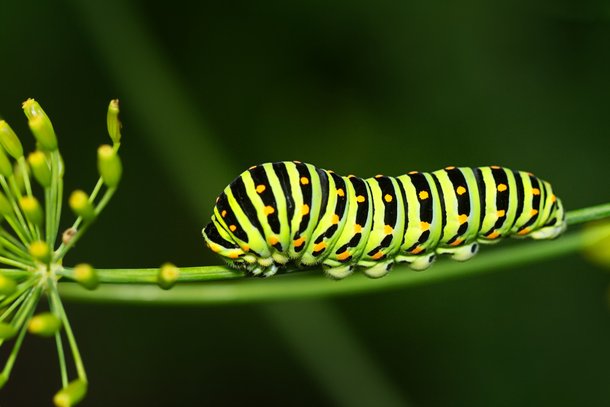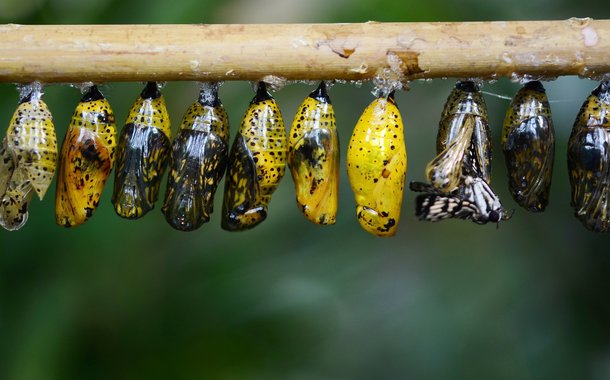A natureza é algo formidável e os animais que vivem nela são provas disso. Veja só as borboletas, por exemplo: essas belas criaturas com asas já foram uma simples lagarta no ado. Portanto, é simplesmente magnifico pensar que um pequeno inseto rastejante se interne em um casulo por alguns dias e saia de lá como um bicho totalmente diferente.
Para alcançar sua “metamorfose completa”, a borboleta a por quatro fases em sua vida: ovo, larva, pupa e adulto. Cada estágio possui um objetivo diferente e é extremamente essencial para a existência dessas espécies. Quer saber mais sobre como as lagartas se transformam em borboletas? Veja só os próximos parágrafos!
Primeira fase: Ovo

A vida de uma borboleta começa como um ovo muito pequeno, podendo ser oval ou cilíndrico. Um fato curioso sobre essas criaturas — especialmente quando falamos sobre as borboletas-monarcas — é que se olharmos bem de perto, podemos ver uma pequenina lagarta sendo desenvolvida dentro do ovo.
Os ovos de borboleta normalmente são depositados pelas fêmeas em folhas de plantas, algo que faz com que fiquem consideravelmente expostos na natureza. No entanto, eles são tão pequenos que dificilmente conseguimos encontrá-los por aí sem ter certa dificuldade.
Segunda fase: Larva
 (Fonte: Pixabay)
(Fonte: Pixabay)
Após o ovo finalmente eclodir, os filhotes de borboleta não nascem como outra borboleta completamente desenvolvida, mas sim como uma larva — ou lagarta, chame como quiser. Um dado curioso é que as lagartas não am muito tempo nesse estágio da vida, uma vez que seu único objetivo nesse momento é se alimentar o máximo possível.
Logo que nasce, uma lagarta inicia seus trabalhos alimentando-se da folha em que seu ovo foi depositado. Esse é um mecanismo muito importante para a sobrevivência dessas criaturas, visto que as mamães borboletas precisam estar atentas em que tipo de folha colocarão seus filhos.
As lagartas só se alimentam de determinados tipos de folha. Além disso, como são pequeninas e não conseguem se locomover de uma planta para outra, esses animais precisar eclodir no “alimento” exato caso queriam seguir para a próxima etapa.
Terceira fase: Pupa
 (Fonte: Pixabay)
(Fonte: Pixabay)
Assim que uma lagarta termina de crescer e atinge seu peso máximo, ela se transforma em uma pupa — também conhecida como crisálida. Do lado de fora desse incrível casulo formado, podemos pensar que o animal está apenas descansado, mas a realidade que acontece no interior é muito mais ativa.
Na pupa, a lagarta está se transformando rapidamente. As antigas partes do seu corpo começam a ar pelo processo chamado de “metamorfose”, evoluindo para as estruturas de uma bela borboleta que irá surgir. Tecidos, membros e órgãos de uma lagarta terão mudado completamente assim que a pupa se romper. A partir desse ponto, esses animais se mostram prontos para a última etapa de suas vidas.
Quarta fase: Borboleta Adulta
Ver uma borboleta sair de dentro da pupa é um dos fenômenos mais magníficos que um ser humano pode ver sobre a vida selvagem. Ao sair da crisálida, as asas de uma borboleta ainda estão macias e dobradas contra seu corpo. Como esse animal precisa encaixar todas as suas novas partes para caber dentro da pupa, isso é algo bem comum.
Porém, em seu primeiro contato com a natureza, essa borboleta ará a bombear sangue para suas novas asas, fazendo com que elas se tornem funcionais e batam firmemente. Então, elas iniciam seu primeiro voo. Normalmente, uma borboleta precisa de três a quatro horas para aprender a voar e então partirá em busca de um parceiro de acasalamento.
Na última fase de suas vidas, as borboletas estão em constante busca por um parceiro reprodutivo. Depois disso, as fêmeas procurarão as folhas ideais para depositar seus ovos e o ciclo da vida recomeçará mais uma vez!
Fonte: MegaCurioso.